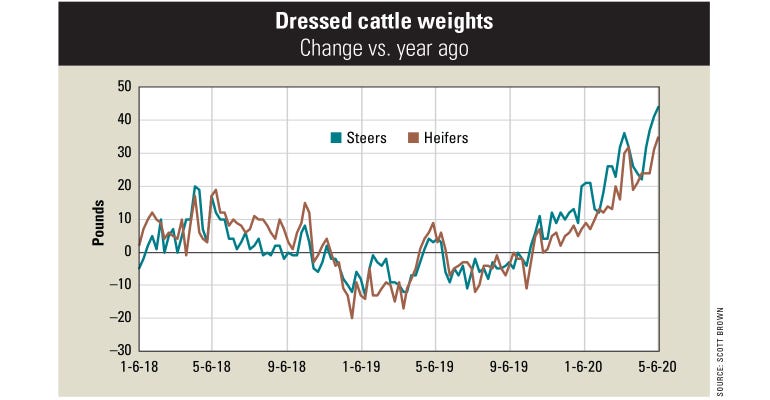June 1, 2020

Cattle processing challenges continue to limit the amount of beef available to consumers. While daily slaughter levels have consistently improved, they have yet to approach levels that would match slaughter-ready cattle supplies, let alone begin to work through the backlog of cattle accumulated during the past two months.
This scenario continues to disrupt normal cattle marketing patterns. The recent monthly USDA Cattle on Feed report showed cattle placed into feedlots with at least 1,000-head capacity during April were more than 22% lower than the previous year for the second consecutive month.
April cattle slaughter recently was reported as nearly 600,000 head below the 2019 level, and estimated daily slaughter data for May points to a similar if not slightly larger decline.
Related: Complete coronavirus coverage
More cattle backlog
While the cattle industry will not suffer through the same euthanization decisions facing hog and poultry producers, there still will be adjustments to normal marketing plans. These will lead to more beef coming to market later this year and into 2021.
A large portion of cattle slaughter is being delayed into future months, and animals are continuing to gain weight. While slaughter weights already were expected to be above last year's because of better feedlot conditions, recent processing limitations are making the increase more pronounced.
Dressed steer weights in early May were more than 40 pounds higher than the year-ago level, adding 5% more beef per animal. Increases of this magnitude will remain the norm until processing facilities are able to first, catch up to current slaughter-ready numbers, and second, work through the backlog that has been growing for about two months now. It could be many more months before this is achieved.

Change in marketing
The takeaway from these market factors is sobering. What perhaps was originally thought to be a short-term, supply-side disruption is looking more and more like a situation that will plague markets well into 2021.
While the demand picture for beef is facing its own share of challenges given economic uncertainty and high unemployment rates, there is reason to remain somewhat optimistic about consumer tastes and preferences for beef. The supply-side backlog, however, will take time to work through.
Plans set to trigger marketings at price levels expected at the beginning of the year need to be adjusted. Holding cattle in the hopes of a relatively quick rebound will only contribute to larger beef and total meat supplies moving forward.
Recognize that any upward movement in cattle prices offers an opportunity to cushion the financial blow to your operation from these turbulent times. There will be upward movements in prices in the weeks and months to come, but the overall effects of this crisis are looking to loom over markets for quite some time. And an industry that seeks to wait this out by delaying marketings for as long as possible likely will only prolong the pain.
Brown is a livestock economist with the University of Missouri. He grew up on a diversified farm in northwest Missouri.
Read more about:
Covid 19About the Author(s)
You May Also Like




